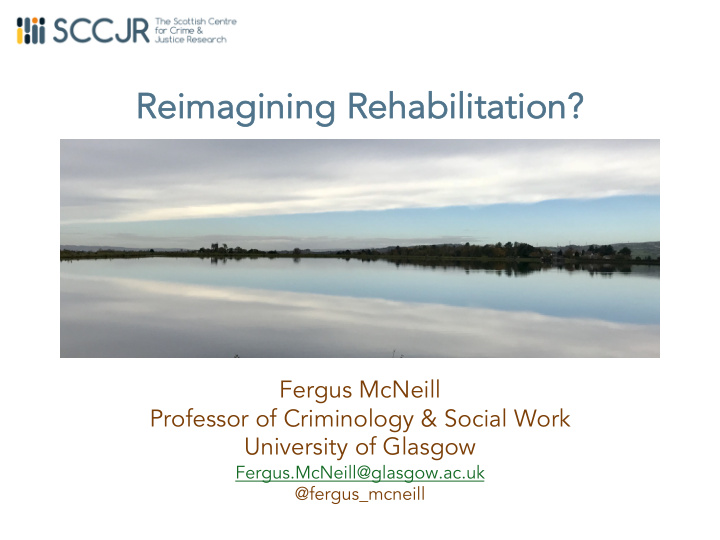



Re Reimagining Re Rehabilitation on? Fergus McNeill Professor of Criminology & Social Work University of Glasgow Fergus.McNeill@glasgow.ac.uk @fergus_mcneill
So Sour urce • McNeill, F. (2014) ‘Punishment as Rehabilitation’, pp. 4195-4206 in, G. Bruinsma and D. Weisburd (eds.), Encyclopedia of Criminology and Criminal Justice , DOI 10.1007/978-1- 4614-5690-2, Springer Science and Business Media: New York. [A final draft version of this paper is available open access online at: http://blogs.iriss.org.uk/discoveringd esistance/files/2012/06/McNeill- When-PisR.pdf] 2
Re Reintegrative ve mom omentum? • ‘As a general social practice, punishment does not merely mark out the punishee’s actions as wrong and blames him for engaging in this wrongful act. It also defines how both punishee and punisher will move forward from here. Th The penal agent lays down the terms of his of s or or her fu future co-ex existenc stence e with th the the offend ffender er in n a sha shared red soc social worl orld. Because this is punishment’s central social function, there there is s rei reinteg ntegra rati tive mo mome mentum m in inherent in in punis ishment that gives the offender himself an interest in being punished. Far from threatening or challenging an offender’s membership in the community, punishment reasserts or reinforces it’ (du Bois Pedain, 2017: 203).
Re Reintegrative ve mom omentum, in p in practic ice? e? • [Even if you don’t agree entirely with that argument, whether you are a a re reducti tivist st or or a retri re tributi tivist st , you have to care about reintegration…] • In practice, re reinte tegra rati tive mome momentum m is very hard to generate and very easily lost by penal agents in three penal moments: – When we sentence – When we implement sentences – When sentences end
Sanctions as Re Redress ss for Breaches of Reciprocities Reparation Re on Retribution Re on (Voluntary (Compulsory contributions) losses) Re Rehabilitation on (as process) Re Rest striction on and ‘Corrections ’ Re Re/integration on (as outcome: Restoration of Reciprocities)
Con Concl clusi sion on: Gener Generating r ing reint eintegr egrativ ive m e moment entum um? • You don’t fix a tear by working on one side • Both the tear and the repair are relational – Between the people involved – Between citizen, civil society and state – Processes of mutual recognition • Structure and culture shape the relational possibilities… and the problems – ‘Corrections’ cannot duck these issues – It is necessary to work on both sides of the tear – The needle hurts but the thread binds; it is better to live with a scar than an open wound.
For more information • Discovering Desistance – http://blogs.iriss.org.uk/discoveringdesistanc e/ • Distant Voices: Coming Home – http://www.voxliminis.co.uk/distant-voices/
Recommend
More recommend